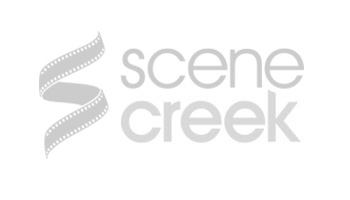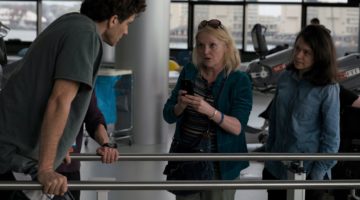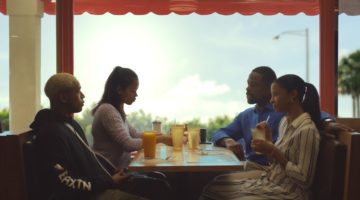5 Questions with Brad Bird of The Iron Giant
The Iron Giant came out initially in 1999 as a part of the wave of films that seemed to anticipate the 2000’s and a rapidly changing landscape. Now that the film’s Signature Edition has been released, The Iron Giant feels almost like a throwback to a throwback, as the nuclear age of the film seems to give way to a premonition of the conflict to come over the next few years.
We had a chance to speak with Brad Bird, the man responsible for bringing Ted Hughes’s story to the screen, during the first weekend of TIFF, where The Iron Giant Signature Edition received its world premiere. He gave off the impression that he could have revealed even more, but what he did say in just about fifteen minutes was especially forthcoming. He serms like the smartest man in the room, (though we were the only two in it), but in a way that’s genuine and relaxed, and not condescending. Bird said clever things like “I’ve never approached animation as a children’s medium. First and foremost, you must want to see it as a movie.” and provided really ample insight into the filmic process, both then and now.
Scene Creek: What has changed since the movie came out?
Brad Bird: Well, I think animation has changed a lot. People don’t really remember it, but at the time that The Iron Giant came out the only computer animated film had been Toy Story. That same year after The Iron Giant, A Bug’s Life came out and so that was Pixar’s only second film. So animation was still very much hand-drawn at the time The Iron Giant came out. I think that animation now obviously has exploded. There are a lot of animated features being made and Pixar had a great hand in that. I think there is a sum, a charitable word would be “democratization”, that computers have made possible, whereas before when it was hand-drawn, you really had to groom artists over a period of time and there weren’t that many people moving in perspective and doing all that stuff. Now, a lot of that work is done by the computer.
That’s good in many ways, I love CG animation when it’s done well. I love the Pixar movies; I’m doing another one with them right now. But (long pause) computer animation has also made it that people who aren’t very careful in their craftsmanship can look better than they actually are. At its worst, it’s akin to Autotune or something like that, where someone can sing out a key, and it corrects them. That aspect of convenience is good for convenience, but not for craftsmanship.
Scene Creek: Did you get your start as an animator?
Brad Bird: Um, sure, yeah! I did my first film when I was thirteen, and that brought me to the attention of Disney, and I got to be mentored by a lot of the Nine Old Men as a kid. I went to Cal Arts with John Lasseter and was in the same class at Cal Arts as John Lasseter and John Musker, who did Aladdin and a lot of other films. That’s kind of where I started. I had worked at Disney, I left Disney. I had finally had the opportunity to make my own film, which was Family Dog, which was an episode of Steven Spielberg’s Amazing Stories, I did not do the TV series, but I did do the episode of Amazing Stories. That brought me to the attention of The Simpsons, where I was a consultant for the first eight seasons. That’s kind of a catch-all phrase. It would be simpler to say that I directed the directors. Originally I was brought on to write a script, but I felt like when I got there, the writing was so well-handled that I felt that I’m just here to learn. But I can help you in putting these ideas in a visual context. So some of those jokes were easy to write, but hard to put across visually, so some of the jokes were like puzzles. Those episodes were done quickly and done overseas, but to me it was like filmmaking bootcamp, because there was always another problem, another thing coming down the conveyor belt. In a way, it was perfect training for The Iron Giant, where we had limited resources but very big ambitions.
Scene Creek: Not many people know that the story was written by Ted Hughes.
Brad Bird: Well, it’s right there in the credits! In England, nobody is surprised because it’s almost considered part of every kid’s reading when they’re in school, everyone knows that story. So in England, it was kind of sacred ground. I was relieved that Ted Hughes, before he died, read our version and liked it, even though it went in a different direction than his book. I really reacted well to reading his story, and something touched me very much when reading his story about the little boy and the giant.
Scene Creek: Do you think that the audience understood the symbolism?
Brad Bird (laughing) Well, there wasn’t much of an audience at the time. People really didn’t know what it was. The marketing had not prepared people. Animation doesn’t have live action faces that people can gravitate towards. They need time to be introduced to the marketplace. That’s why they start advertising animated movies a year or more in advance because it’s just trying to get into people’s consciousness. We didn’t have that for this film. Our first artwork became available visually, a month or two before the film’s release. People didn’t know what it was. A lot of people thought that it was Japanese or something, that it had been dubbed. People really had to sort of discover this film. We have always been blessed by good word of mouth when people discover this film. They told people to see it, and those people tell told people to see it, and it has managed to stick around in a way that’s very gratifying.
Scene Creek: What will people watching it for the first time discover?
Brad Bird: Well, it’s a film that sneaks up on you a little bit. It doesn’t begin like most animated films begin. It begins with a shot of Sputnik and a storm on Earth and then something heads directly into the storm. That’s an usual way for an animated film to open. I think people will key into this relationship between this boy and this giant, but I think that they’ll be surprised by the directions that the story goes into. It’s a different sort of film. I think people are usually surprised by it.
The shot of Tomorrowland was something that I wanted to do in the original release and that little bit of time was perfectly measured for that clip. The person who was running the film division at Disney at that time didn’t want Disney animation of any sort to appear in a competitor’s film. Since then I’ve made three films for Disney and they’re in a different state of mind. This time, I said “can I have that clip” and they were like, “great”, so it happened with no trouble at all. It was a way for me to tip my hat to the guys that trained me. It took on a slightly different significance now because it seems like it’s promoting the movie. But that was actually the original intent to be in that spot. Twelve years before anyone imagined that there would be a movie of Tomorrowland. These were scenes that were originally planned for the film, and we didn’t have the bandwidth to do them, whether it was the time or the money and they weren’t absolutely essential. But when Warner said “is there anything you’d like to include because it would be cool or a nice little thing or a treat for people?” and I mentioned these two. One of them is a scene in the diner with Annie and Dean, and the other one is the Giant’s dream in the junkyard. I think these scenes add some colour to the film, and we got some original members of the animation team to work on them. I don’t think you can tell what was done back then and what was done now.
The Iron Giant is the kind of thing that points out that time really is the best critic and when movies are divorced from the stuff that’s happening that moment right around them and they’re allowed to be stories standing alone, they’re seen and received differently than if there’s other stuff happening around them.
I think that The Iron Giant‘s perceived differently now that it’s a post-9/11 environment than it was then and I think that that is hopefully true of other movies that they take on a different meaning over time.
The Iron Gian Signature Edition opens October 16th at the TIFF Bell Lightbox.



